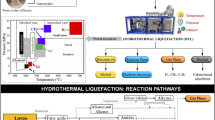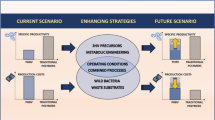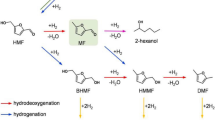Abstract
In order to optimize the production of biobased platform chemicals, such as 5-hydroxymethylfurfural (HMF) and levulinic acid (LA), from biomass and sugars, reaction conditions have to be optimized. This article assesses the impact of acidity on the kinetic parameters of the hydrothermal conversion of fructose at 150 °C. The reaction parameters were varied in time (5–180 min), acid (NaHSO4, H3PO4, citric acid, and formic acid), and acid concentration (0.016 to 1.6 mol/l). The experimental data were evaluated with a novel kinetic model that includes the formation of HMF, LA, and humins. While it was expected that the dehydration rate of fructose to HMF and rehydration rate of HMF to levulinic acid depend linearly on the proton concentration, the results show that there is actually an exponential relationship. This can be explained by the participation of the acid rest ion in the dehydration and rehydration reactions. In contrast, the humin formation rate depends linearly on the proton concentration, and also, the sensitivity of this relationship is rather low. This clarifies why high acid concentrations or proton concentrations, respectively, increase the formation of LA to an expense of the humin formation.















Similar content being viewed by others
References
Van PR, Van Der WJC, De JE, et al (2013) Hydroxymethylfurfural, a versatile platform chemical made from renewable resources. doi: https://doi.org/10.1021/cr300182k
Steinbach D, Kruse A, Sauer J (2017) Pretreatment technologies of lignocellulosic biomass in water in view of furfural and 5-hydroxymethylfurfural production- a review. Biomass Convers Biorefinery 1–28. doi: https://doi.org/10.1007/s13399-017-0243-0
de Carvalho EGL, Rodrigues F de A, Monteiro RS et al (2018) Experimental design and economic analysis of 5-hydroxymethylfurfural synthesis from fructose in acetone-water system using niobium phosphate as catalyst. Biomass Convers Biorefinery 8:635–646. https://doi.org/10.1007/s13399-018-0319-5
Graham BJ, Raines RT (2019) Efficient metal-free conversion of glucose to 5-hydroxymethylfurfural using a boronic acid. Biomass Convers Biorefinery 9:471–477. https://doi.org/10.1007/s13399-018-0346-2
Tsilomelekis G, Josephson TR, Nikolakis V, Caratzoulas S (2014) Origin of 5-hydroxymethylfurfural stability in water/dimethyl sulfoxide mixtures. ChemSusChem 7:117–126. https://doi.org/10.1002/cssc.201300786
Kang S, Pan J, Gu G et al (2018) Sequential production of levulinic acid and porous carbon material from cellulose. Materials (Basel) 11:1408. https://doi.org/10.3390/ma11081408
Girisuta B, Janssen LPBM, Heeres HJ (2006) A kinetic study on the decomposition of 5-hydroxymethylfurfural into levulinic acid. Green Chem 8:701. https://doi.org/10.1039/b518176c
Ryu J, Suh Y-W, Suh DJ, Ahn DJ (2010) Hydrothermal preparation of carbon microspheres from mono-saccharides and phenolic compounds. Carbon N Y 48:1990–1998. https://doi.org/10.1016/j.carbon.2010.02.006
Poerschmann J, Weiner B, Wedwitschka H et al (2015) Characterization of biochars and dissolved organic matter phases obtained upon hydrothermal carbonization of Elodea nuttallii. Bioresour Technol 189:145–153. https://doi.org/10.1016/j.biortech.2015.03.146
Van Zandvoort I, Wang Y, Rasrendra CB et al (2013) Formation, molecular structure, and morphology of humins in biomass conversion: influence of feedstock and processing conditions. ChemSusChem 6:1745–1758. https://doi.org/10.1002/cssc.201300332
Hassanzadeh S, Aminlashgari N, Hakkarainen M (2014) Chemo-selective high yield microwave assisted reaction turns cellulose to green chemicals. Carbohydr Polym 112:448–457. https://doi.org/10.1016/j.carbpol.2014.06.011
Jung D, Zimmermann M, Kruse A (2018) Hydrothermal carbonization of fructose: growth mechanism and kinetic model. ACS Sustain Chem Eng acssuschemeng.8b02118 . doi: https://doi.org/10.1021/acssuschemeng.8b02118
Chang C, MA X, CEN P (2006) Kinetics of levulinic acid formation from glucose decomposition at high temperature. Chin J Chem Eng 14:708–712. https://doi.org/10.1016/S1004-9541(06)60139-0
Weingarten R, Cho J, Xing R et al (2012) Kinetics and reaction engineering of levulinic acid production from aqueous glucose solutions. ChemSusChem 5:1280–1290. https://doi.org/10.1002/cssc.201100717
Girisuta B, Janssen LPBM, Heeres HJ (2007) Kinetic study on the acid-catalyzed hydrolysis of cellulose to levulinic acid. Ind Eng Chem Res 46:1696–1708. https://doi.org/10.1021/ie061186z
Shen J, Wyman CE (2012) Hydrochloric acid-catalyzed levulinic acid formation from cellulose: data and kinetic model to maximize yields. Jiacheng AlChE J 58:236–246. https://doi.org/10.1002/aic.12556
Girisuta B, Janssen LPBM, Heeres HJ (2006) A kinetic study on the conversion of glucose to levulinic acid. Chem Eng Res Des 84:339–349. https://doi.org/10.1205/cherd05038
Weiqi W, Shubin W (2017) Experimental and kinetic study of glucose conversion to levulinic acid catalyzed by synergy of Lewis and Bronsted acids. Chem Eng J 307:389–398. https://doi.org/10.1016/j.cej.2016.08.099
Swift TD, Bagia C, Choudhary V et al (2014) Kinetics of homogeneous Brønsted acid catalyzed fructose dehydration and 5-hydroxymethyl furfural rehydration: a combined experimental and computational study. ACS Catal 4:259–267. https://doi.org/10.1021/cs4009495
Jiang Y, Yang L, Bohn CM et al (2015) Speciation and kinetic study of iron promoted sugar conversion to 5-hydroxymethylfurfural (HMF) and levulinic acid (LA). Org Chem Front 2:1388–1396. https://doi.org/10.1039/C5QO00194C
Fachri BA, Abdilla RM, De BHHV et al (2015) Experimental and kinetic modeling studies on the sulfuric acid catalyzed conversion of d -fructose to 5-hydroxymethylfurfural and levulinic acid in water. ACS Sustain Chem Eng 3:3024–3034. https://doi.org/10.1021/acssuschemeng.5b00023
Tan-Soetedjo JNM, Van De Bovenkamp HH, Abdilla RM et al (2017) Experimental and kinetic modeling studies on the conversion of sucrose to levulinic acid and 5-hydroxymethylfurfural using sulfuric acid in water. Ind Eng Chem Res 56:13228–13239. https://doi.org/10.1021/acs.iecr.7b01611
Yan L, Greenwood AA, Hossain A, Yang B (2014) A comprehensive mechanistic kinetic model for dilute acid hydrolysis of switchgrass cellulose to glucose, 5-HMF and levulinic acid. RSC Adv 4:23492. https://doi.org/10.1039/c4ra01631a
Shi N, Liu Q, Cen H et al (2019) Formation of humins during degradation of carbohydrates and furfural derivatives in various solvents. Biomass Convers Biorefinery. https://doi.org/10.1007/s13399-019-00414-4
Steinbach D, Kruse A, Sauer J, Vetter P (2018) Sucrose is a promising feedstock for the synthesis of the platform chemical hydroxymethylfurfural. Energies 11:645. https://doi.org/10.3390/en11030645
Körner P, Jung D, Kruse A (2018) The effect of different Brønsted acids on the hydrothermal conversion of fructose to HMF. Green Chem 20:2231–2241. https://doi.org/10.1039/C8GC00435H
Patil SKR, Lund CRF (2011) Formation and growth of humins via aldol addition and condensation during acid-catalyzed conversion of 5-hydroxymethylfurfural. Energy Fuel 25:4745–4755. https://doi.org/10.1021/ef2010157
Rasrendra CB, Windt M, Wang Y et al (2013) Experimental studies on the pyrolysis of humins from the acid-catalysed dehydration of C6-sugars. J Anal Appl Pyrolysis 104:299–307. https://doi.org/10.1016/j.jaap.2013.07.003
Poerschmann J, Weiner B, Koehler R, Kopinke F-D (2017) Hydrothermal carbonization of glucose, fructose, and xylose—identification of organic products with medium molecular masses. ACS Sustain Chem Eng 5:6420–6428. https://doi.org/10.1021/acssuschemeng.7b00276
Li M, Li W, Liu SX (2012) Control of the morphology and chemical properties of carbon spheres prepared from glucose by a hydrothermal method. J Mater Res 27:1117–1123. https://doi.org/10.1557/jmr.2011.447
Titirici M-M, Antonietti M, Baccile N (2008) Hydrothermal carbon from biomass: a comparison of the local structure from poly- to monosaccharides and pentoses/hexoses. Green Chem 10:1204. https://doi.org/10.1039/b807009a
Sevilla M, Fuertes AB (2009) Chemical and structural properties of carbonaceous products obtained by hydrothermal carbonization of saccharides. Chem - A Eur J 15:4195–4203. https://doi.org/10.1002/chem.200802097
García-Bordejé E, Pires E, Fraile JM (2017) Parametric study of the hydrothermal carbonization of cellulose and effect of acidic conditions. Carbon N Y 123:421–432. https://doi.org/10.1016/j.carbon.2017.07.085
Latham KG, Jambu G, Joseph SD, Donne SW (2014) Nitrogen doping of hydrochars produced hydrothermal treatment of sucrose in H2O, H2SO4, and NaOH. ACS Sustain Chem Eng 2:755–764. https://doi.org/10.1021/sc4004339
Helgeson HC (1967) Thermodynamics of complex dissociation in aqueous solution at elevated temperatures. J Phys Chem 71:3121–3136. https://doi.org/10.1021/j100869a002
Chang C, Ma X, Cen P (2009) Kinetic studies on wheat straw hydrolysis to levulinic acid. Chinese J Chem Eng 17:835–839. https://doi.org/10.1016/S1004-9541(08)60284-0
Chuntanapum A, Matsumura Y (2009) Formation of tarry material from 5-HMF in subcritical and supercritical water. Ind Eng Chem Res 48:9837–9846. https://doi.org/10.1021/ie900423g
Knežević D, Van Swaaij WPM, Kersten SRA (2009) Hydrothermal conversion of biomass: I , glucose conversion in hot compressed water. Ind Eng Chem Res 48:4731–4743
Kruse A, Grandl R (2015) Hydrothermale karbonisierung: 3. Kinetisches modell. Chemie-Ingenieur-Technik 87:449–456. https://doi.org/10.1002/cite.201400116
Patil SKR, Heltzel J, Lund CRF (2012) Comparison of structural features of humins formed catalytically from glucose, fructose, and 5-hydroxymethylfurfuraldehyde. Energy Fuels 26:5281–5293. https://doi.org/10.1021/ef3007454
Tsilomelekis G, Orella MJ, Lin Z et al (2016) Molecular structure, morphology and growth mechanisms and rates of 5-hydroxymethyl furfural (HMF) derived humins. Green Chem 18:1983–1993. https://doi.org/10.1039/C5GC01938A
Zhang M, Yang H, Liu Y et al (2012) Hydrophobic precipitation of carbonaceous spheres from fructose by a hydrothermal process. Carbon N Y 50:2155–2161. https://doi.org/10.1016/j.carbon.2012.01.024
Salak Asghari F, Yoshida H (2006) Acid-catalyzed production of 5-hydroxymethyl furfural from D-fructose in subcritical water. Ind Eng Chem Res 45:2163–2173. https://doi.org/10.1021/ie051088y
Luijkx GCA, van Rantwijk F, van Bekkum H (1993) Hydrothermal formation of 1,2,4-benzenetriol from 5-hydroxymethyl-2-furaldehyde and d-fructose. Carbohydr Res 242:131–139. https://doi.org/10.1016/0008-6215(93)80027-C
Kumalaputri AJ, Randolph C, Otten E et al (2018) Lewis acid catalyzed conversion of 5-hydroxymethylfurfural to 1,2,4-benzenetriol, an overlooked biobased compound. ACS Sustain Chem Eng 6:3419–3425. https://doi.org/10.1021/acssuschemeng.7b03648
Maruani V, Narayanin-Richenapin S, Framery E, Andrioletti B (2018) Acidic hydrothermal dehydration of D-Glucose into humins: identification and characterization of intermediates. ACS Sustain Chem Eng 6:13487–13493. https://doi.org/10.1021/acssuschemeng.8b03479
Zhang M, Yang H, Liu Y et al (2012) First identification of primary nanoparticles in the aggregation of HMF. Nanoscale Res Lett 7:38. https://doi.org/10.1186/1556-276X-7-38
Gozan M, Panjaitan JRH, Tristantini D et al (2018) Evaluation of separate and simultaneous kinetic parameters for levulinic acid and furfural production from pretreated palm oil empty fruit bunches. Int J Chem Eng 2018. https://doi.org/10.1155/2018/1920180
Dussan K, Girisuta B, Haverty D et al (2013) Kinetics of levulinic acid and furfural production from Miscanthus×giganteus. Bioresour Technol 149:216–224. https://doi.org/10.1016/j.biortech.2013.09.006
Zheng X, Zhi Z, Gu X et al (2017) Kinetic study of levulinic acid production from corn stalk at mild temperature using FeCl3 as catalyst. Fuel 187:261–267. https://doi.org/10.1016/j.fuel.2016.09.019
Oscarson JL, Izatt RM, Brown PR et al (1988) Thermodynamic quantities for the interaction of SO42- with H+ and Na+ in aqueous solution from 150 to 320°C. J Solut Chem 17:841–863. https://doi.org/10.1007/BF00646553
Larson JW, Zeeb KG, Hepler LG (2006) Heat capacities and volumes of dissociation of phosphoric acid (1st, 2nd, and 3rd), bicarbonate ion, and bisulfate ion in aqueous solution. Can J Chem 60:2141–2150. https://doi.org/10.1139/v82-306
Marshall WL, Jones EV (1966) Second dissociation constant of sulfuric acid from 25 to 350° evaluated from solubilities of calcium sulfate in sulfuric acid solutions 1,2. J Phys Chem 70:4028–4040. https://doi.org/10.1021/j100884a045
Lietzke MH, Stoughton RW, Young TF (2007) The bisulfate acid constant from 25 to 225° as computed from solubility data 1. J Phys Chem 65:2247–2249. https://doi.org/10.1021/j100829a036
Hansen TS, Mielby J, Riisager A (2011) Synergy of boric acid and added salts in the catalytic dehydration of hexoses to 5-hydroxymethylfurfural in water. Green Chem 13:109–114. https://doi.org/10.1039/C0GC00355G
Wrigstedt P, Keskiväli J, Leskelä M, Repo T (2015) The role of salts and Brønsted acids in Lewis acid-catalyzed aqueous-phase glucose dehydration to 5-hydroxymethylfurfural. ChemCatChem 7:501–507. https://doi.org/10.1002/cctc.201402941
Ståhlberg T, Rodriguez-Rodriguez S, Fristrup P, Riisager A (2011) Metal-free dehydration of glucose to 5-(hydroxymethyl)furfural in ionic liquids with boric acid as a promoter. Chem - A Eur J 17:1456–1464. https://doi.org/10.1002/chem.201002171
Wang C, Fu L, Tong X et al (2012) Efficient and selective conversion of sucrose to 5-hydroxymethylfurfural promoted by ammonium halides under mild conditions. Carbohydr Res 347:182–185. https://doi.org/10.1016/j.carres.2011.11.013
Binder JB, Raines RT (2009) Simple chemical transformation of lignocellulosic biomass into furans for fuels and chemicals. J Am Chem Soc 131:1979–1985. https://doi.org/10.1021/Ja808537j
Binder JB, Cefali AV, Blank JJ, Raines RT (2010) Mechanistic insights on the conversion of sugars into 5-hydroxymethylfurfural. Energy Environ Sci 3:765. https://doi.org/10.1039/b923961h
Wrigstedt P, Keskiväli J, Perea-Buceta JE, Repo T (2017) One-pot transformation of carbohydrates into valuable furan derivatives via 5-hydroxymethylfurfural. ChemCatChem 9:4244–4255. https://doi.org/10.1002/cctc.201701106
Körner P, Beil S, Kruse A (2019) Effect of salt on the formation of 5-hydroxymethylfurfural from ketohexoses under aqueous conditions. React Chem Eng. https://doi.org/10.1039/C8RE00300A
Horvat J, Klaic B, Metelko B, Sunjic V (1986) Mechanism of levulinic acid formation in acid catalyzed hydrolysis of 2-(hydroxymethyl)furan and 5-(hydroxymethyl)-2-furancarboxaldehyde. Croat Chem Acta 59:429–438. https://doi.org/10.1080/02724634.2015.1031341
Acknowledgements
Special thanks are given to the Paul and Yvonne Gillet Foundation, who supported Dennis Jung with a generous grant.
The work of Paul Körner was supported by a State Graduate Scholarship and is part of the bioeconomy graduate program BBW ForWerts.
Thanks to Avery Brown for his helpful comments on the manuscript.
Author information
Authors and Affiliations
Contributions
Dennis Jung and Paul Körner contributed equally.
Corresponding author
Ethics declarations
Conflict of interest
The authors declare that they have no conflict of interest.
Additional information
Publisher’s note
Springer Nature remains neutral with regard to jurisdictional claims in published maps and institutional affiliations.
Electronic supplementary material
ESM 1
(DOCX 1428 kb)
Rights and permissions
About this article
Cite this article
Jung, D., Körner, P. & Kruse, A. Kinetic study on the impact of acidity and acid concentration on the formation of 5-hydroxymethylfurfural (HMF), humins, and levulinic acid in the hydrothermal conversion of fructose. Biomass Conv. Bioref. 11, 1155–1170 (2021). https://doi.org/10.1007/s13399-019-00507-0
Received:
Revised:
Accepted:
Published:
Issue Date:
DOI: https://doi.org/10.1007/s13399-019-00507-0




